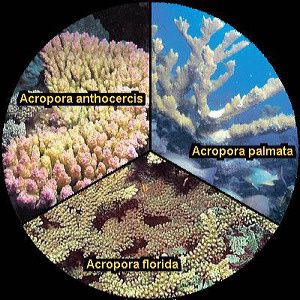Acropora coral is a genus of polyp stony coral belonging to the Cnidaria Phylum. This species rich genera - 149 species have been described, but it is believed that there are in excess of 350 species in the genus - are important in reef building, often dominating vast sections of the tropical coral reefs found around the Indo-Pacific, although a few species - though not as abundant - can be found in tropical Atlantic regions.
 Habitat
Habitat
Acropora corals predominantly live within shallow reef environments in the oceans surrounding Africa, American Samoa and Asia; Australia, the British Indian Ocean Territory and Central America; Europe, the Middle East and North America (US Territory), as well as Oceania and South America. Constraint to the water-surface in order to make the most out of the sun's energy, Acropora corals prefer medium to high water motion. As a rule, shoals of small fish can be found within these living 'forests'.
Biology and Ecology
Growing as plates, slender or comparatively broad branches - depending on the location and the species - Acropora corals are colonies of small organisms called polyps. Approximately 2 mm in diameter, the polyps protrude slightly from the coral - typically more so during the night - to capture and feed on dissolved organic matter and plankton. Unexpected movement and the arrival of potential predators will cause the polyps to withdraw back into the coral until the coast is clear, so to speak.
Colonies of Acropora coral share both a nerve net and tissue. Because the skeleton, or corallite of new polyps is created by somewhat specialised axial corralites, which form the tips of branches, the whole colony is closely interconnected, making it possible for the colony to grow rapidly in a coordinated manner.
Like many other corals, Acropora species have a symbiotic relationship with zooxanthellae, a type of algae. The coral provides a safe environment for the algae within its tissue, while the algae uses photosynthesis to provide nutrients for the coral. On average, approximately 70 per cent of the coral's nutrients are obtained in this manner, but it will also feed on zooplankton.
Reproduction occurs either sexually or asexually. For sexual reproduction, streams of eggs and sperm are released into the water. Some of the larvae resulting from fertilisation of eggs will settle on the original reef, while others may drift around the oceans for months before finally settling on far away reefs.
Asexual reproduction occurs when a branch breaks off the colony, becomes re-attached to the substrate and continues to grow from there. This process is also known as fragmentation, and is often used to grow coral for aquariums. The majority of corals will reach maturity at an age of between three and eight years, and it is believed that normal life expectancy is somewhere above ten years.
 Threats to Acropora Coral
Threats to Acropora Coral
The most common threats to Acropora and other corals include pollution, abnormally high water temperatures and eutrophication (excess nutrients stimulating excessive plant growth); sedimentation and increased acidification of oceans. One of the first signs of corals being stressed by one or more of these causes is bleaching, which is the direct result of the loss of zooxanthellae. The bleached coral will have a stark white appearance, and, if new zooxanthellae can not be assimilated, will eventually die.
Another real threat is over-fishing and diseases in predatory and plant-eating fish. As the numbers of, for example, groupers and parrot fish decline, organisms that prey on Acropora polyps - such as, for instance, damsel fish, fire worms and short coral snails - thrive. In addition, a lack of herbivorous fish allows macro algae growth to explode, limiting the recovery of already stressed corals and settling of coral larvae.
The sad News
Sadly, at present around 76 species of Acropora corals are listed as endangered. These species include:
- A. willisae
- A. walindii
- A. verweyi
- A. vaughani
- A. turaki
- A. tenuis
- A. tenella
- A. suharsonoi
- A. striata
- A. spicifera
- A. speciosa
- A. solitaryensis
- A. simplex
- A. selago
- A. secale
- A. russelli
- A. rudis
- A. roseni
- A. retusa
- A. polystoma
- A. plumosa
- A. pichoni
- A. pharaonis
- A. papillare
- A. paniculata
- A. palmerae
- A. palmata, or Elkhorn Coral
- A. nasuta
- A. nana, or A. azurea
- A. multiacuta
- A. monticulosa
- A. millepora
- A. microclados
- A. lutkeni
- A. lovelli
- A. loripes
- A. lokani
- A. loisetteae
- A. listeri
- A. kosurini
- A. kirstyae
- A. kimbeensis
- A. jacquelineae
- A. indonesia
- A. hyacinthus, or Brush Coral
- A. humilis, or Finger Coral
- A. horrida
- A. hoeksemai
- A. hemprichii
- A. granulosa
- A. globiceps
- A. glauca
- A. formosa
- A. florida, or Branch Coral
- A. elegans
- A. echinata
- A. donei
- A. divaricata
- A. digitifera
- A. desalwii
- A. derawanensis
- A. dendrum
- A. cervicornis
- A. caroliniana
- A. carduus
- A. batunai
- A. awi
- A. austera
- A. aspera
- A. arabensis
- A. appressa
- A. anthocercis, or Red Table Coral
- A. acuminata
- A. aculeus
- A. abrolhosensis, or Fuzzy Staghorn
Conservation Measures
Fortunately, many coral reefs are already under protection, and in some areas, active measures are being undertaken to encourage the growth of new colonies. The drawback to these measures, however, is the fact that oceans continue to be polluted, over-fished and generally abused, and worldwide climate changes continue to heat up oceans everywhere.
Sources:
http://www.earthsendangered.com/profile.asp?gr=COR&view=all&ID=1&sp=9362



